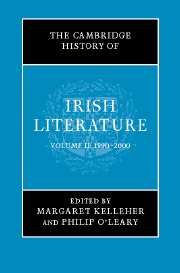Book contents
- Frontmatter
- Introduction
- 1 Literature and politics
- 2 The Irish Renaissance, 1890–1940: poetry in English
- 3 The Irish Renaissance, 1890–1940: prose in English
- 4 The Irish Renaissance, 1890–1940: drama in English
- 5 The Irish Renaissance, 1880–1940: literature in Irish
- 6 Contemporary prose and drama in Irish 1940–2000
- 7 Contemporary poetry in Irish: 1940–2000
- 8 Contemporary poetry in English: 1940–2000
- 9 Contemporary prose in English: 1940–2000
- 10 Contemporary drama in English: 1940–2000
- 11 Cinema and Irish literature
- 12 Literary historiography, 1890–2000
- Afterword: Irish-language literature in the new millennium
- Afterword: Irish literature in English in the new millennium
- Guide to major subject areas
- Index
- References
7 - Contemporary poetry in Irish: 1940–2000
Published online by Cambridge University Press: 28 March 2008
- Frontmatter
- Introduction
- 1 Literature and politics
- 2 The Irish Renaissance, 1890–1940: poetry in English
- 3 The Irish Renaissance, 1890–1940: prose in English
- 4 The Irish Renaissance, 1890–1940: drama in English
- 5 The Irish Renaissance, 1880–1940: literature in Irish
- 6 Contemporary prose and drama in Irish 1940–2000
- 7 Contemporary poetry in Irish: 1940–2000
- 8 Contemporary poetry in English: 1940–2000
- 9 Contemporary prose in English: 1940–2000
- 10 Contemporary drama in English: 1940–2000
- 11 Cinema and Irish literature
- 12 Literary historiography, 1890–2000
- Afterword: Irish-language literature in the new millennium
- Afterword: Irish literature in English in the new millennium
- Guide to major subject areas
- Index
- References
Summary
The excitement generated by Seán Ó Tuama’s 1950 anthology Nuabhéarsaíocht is evident in the publishers’ claim that the collection would vindicate those who believed any worthwhile literature Ireland might produce in the future would be written in Irish. The advertisement for the book in advance of its publication goes on to declare, with enthusiasm bordering on the belligerent, that Ó Tuama’s selection of poems from the previous decade should silence those who believe the term ‘Irish’ to be nothing more than a useful geographical definition. The idea that the emergence of a Modernist poetics confidently articulated in Irish corresponds to a more widespread sense of national renewal during and following the Second World War is further articulated in Ó Tuama’s considered, but nonetheless polemical, introduction and reiterated enthusiastically by contemporary reviewers. In a review published in Feasta in February 1951, Criostóir Mac Aonghusa, a careful and scrupulous critic, suggests the achievement of the poets whose work is included in Nuabhéarsaíocht is such that a revival in the fortunes of Irish is imminent, that if Irish people have sufficient courage to commit themselves to learning the language, ‘níl sé beo an té chuirfeadh gobán ina mbéal’ (no one could silence them).
Nuabhéarsaíocht contains poems by twenty-one poets published between 1939 and 1949. That most of those included were not native speakers of Irish anticipates the accelerated development of the modern lyric mode in Irish away from the vigorous tradition of folk or community poetry that continues to be the dominant form of poetry in Gaeltacht areas.
- Type
- Chapter
- Information
- The Cambridge History of Irish Literature , pp. 317 - 356Publisher: Cambridge University PressPrint publication year: 2006
References
- 3
- Cited by

